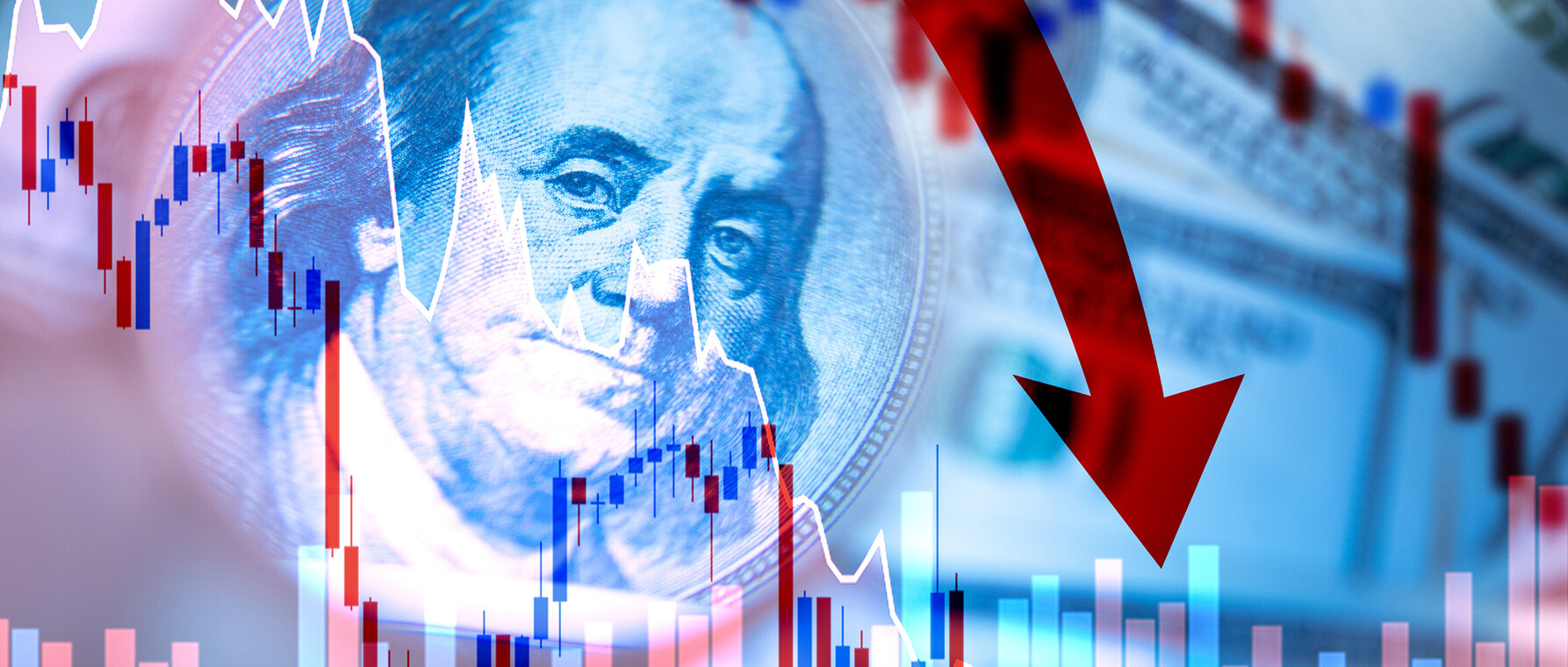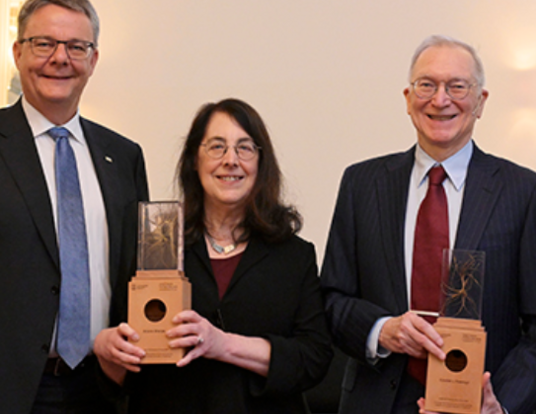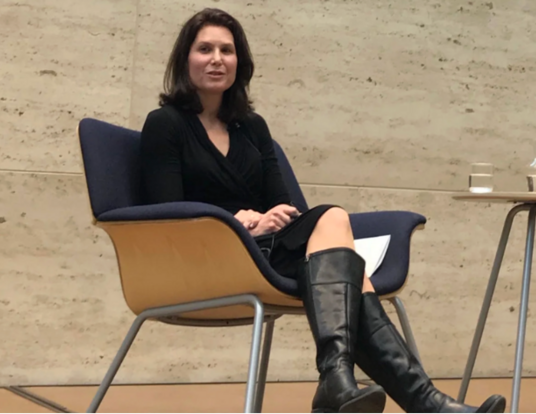Boom, Bust, or Simply Getting Better?
Two of the country's leading economists try to make sense of the numbers

If the only economic data you had access to was the number of jobs created each month—a whopping 528,000 in July 2022—you’d think the US was in the midst of a historic boom. If the only data you saw was the quarterly change in gross domestic product (GDP), you might think the country was entering a recession. And if you only knew about inflation, you might rub your eyes and wonder if you’d awakened in the 1970s.
To help make sense of a time that perplexes consumers, producers, and policymakers alike, GSAS Communications reached out to two of the country’s leading economists, both alumni of the School. Betsey Stevenson, PhD ’01, is professor of public policy and economics at the University of Michigan and served as a member of the Council of Economic Advisers during the Obama Administration. In 2014, the International Monetary Fund named Justin Wolfers, PhD ’01, also a professor at the University of Michigan, one of the "25 Economists Under 45 Who Are Shaping the Way We Think About the Global Economy." Together the two host the popular podcast, Think Like an Economist. They share their takes on the prospect of a recession, whether consumers can expect some relief from rising prices, and where they the US economy could be headed next.
Hiring surged in July, but inflation is high. Personal income is up, but GDP is down. How should we feel about this economy?
Justin Wolfers: Think back to the dark days of March and April 2020. The economy was in freefall because of the pandemic. It was the sharpest downturn since the Great Depression and no one knew where the bottom was. If you had promised me that just two years later we’d have an economy with unemployment almost at a 50-year low and new businesses opening at record rates—with an asterisk that the cost of living was rising faster than most people hoped—I would have hugged you.

Sometimes we talk about economic policy as getting to choose the future we want. A better framing might be that we get to choose what mistakes we risk making. I would much rather have made the mistake of overheating the economy, avoiding a depression, getting people back to work, and risking a bit of inflation than the mistake we made in 2008, which was being cautious and learning year after year that the economy wasn’t going to repair itself.
Betsey Stevenson: The question is, “Which side of the problem do you want to be on?” A slightly overheated economy where everybody has jobs is exactly the side I want to be on. We made the opposite mistake in 2008. The recovery took so long that many of the older workers who lost their jobs never worked again
Sure, but the economy contracted at an annual rate of .9 percent last quarter—the second consecutive quarterly decline in GDP. Doesn't that mean we're in a recession?
Betsey Stevenson: I think that we're not in a recession, currently, but we could fall into one.
Let's think about what happened in the last few quarters. Consumer spending was still expanding. We saw a decrease in private inventory investment, which means companies are slowing down what they're producing and selling off what they have. We saw a decline in residential fixed investment, which means the housing market is starting to slow. Those are all things we expect because of the Fed (the Federal Reserve) raising interest rates. When you take a look at where the slowdowns are coming from, it's not what we see traditionally in a recession. There is no recession in employment or corporate earnings or household spending.
Justin Wolfers: Think about a baseball team. You can look at its earned run average. That can tell you something about the strength of its pitching staff. But only a fool would look just at that one statistic. There’s on-base percentage, runs batted in, and so on. The same thing is true for the economy. GDP, that's a bit like your batting average. Maybe it looks weak, but other statistics look a whole lot better. I think that, when you look at the broad array of statistics, the economy does not look like it's in recession right now.
In July, US employers added an astonishing 528,000 jobs—far above the expectations of analysts and policymakers. What’s your reaction to those numbers and how do you square them with reports that the US economy contracted in both the first and second quarters this year?
Justin Wolfers: The employment numbers definitely suggest that the economy is not in recession right now. If output’s declining and employment’s rising, that means more workers are producing less and that we've all been less productive in 2022 than we were in 2021. That’s very hard to believe. So, one of those numbers—GDP or employment—is probably wrong. It’s always hard to know which one, but historically employment’s been a better indicator. A wide array of other data are also consistent with that assumption.
This isn't the economy we dreamed of or hoped for, but it's certainly a lot better than an economy in which GDP is declining. My guess is that the economy has been growing for much of the first half of the year and we have some momentum going into the second half. The question is where we go next.
Betsey Stevenson: We still see a very tight labor market. Employers have record numbers of openings. We have workers who are easily able to change jobs. And we have hiring at frankly unsustainably high levels. That is simply inconsistent with declining GDP. So, I think some of the data we’re seeing is going to be revised. We may see that GDP declined less than we thought.
Bottom line: Employers are clearly continuing to meet demand by expanding hiring. We are still in the midst of an economic boom. But equally, the necessary efforts to reduce inflation continue to put the economy at risk of a recession.
When Betsey spoke with GSAS last fall, the annual rate of inflation in the US was 5.4 percent. How did we get to 9.1 percent?
Betsey Stevenson: One very important thing that happened is that Russia invaded Ukraine and pushed up global energy and food prices. That’s not something that monetary or fiscal policymakers have a lot of control over.
What we really worry about is not the 9.1 percent, although that's very painful for people. What we worry about is underlying inflation: what is the likely ongoing inflation rate going forward? If we strip out the one-time increase from the Russian invasion, it's still hot inflation for the United States, but probably running around 4 to 5 percent and not 9.1 percent.
Justin Wolfers: We see hot inflation not just in the US, but in the European Union, in Britain, in Canada, in Australia. What do all these countries have in common? One thing is they're all exposed to global energy markets. Another is they've all been exposed to the pandemic and the supply chain problems it’s caused. So, a large part of this is common across countries. The question is whether these blips can move out of the system quickly before a broader inflation psychology develops.
Break down the inflation we’re seeing. Are there items that make up the bulk of the rise in prices?
Betsey Stevenson: Let’s break it down to durable goods, nondurable goods, and services. Our current high inflation started with durable goods before the surge in oil prices. It was caused in part by consumers stuck at home wanting to buy stuff. I can no longer go to the gym, so I'll buy a treadmill or buy free weights. I can no longer go out to dinner, so I'm going to remodel my kitchen. I no longer want to ride public transportation because of COVID, so I want to buy a car.
Then there was the supply side. The auto industry, as one example, thought there was going to be a big COVID recession, so they scaled back production. Normally, that would make sense because people cut back on durable goods first in a recession. But consumers did the exact opposite and that led to exploding prices on durable goods. And when manufacturers tried to respond, supply chain problems kicked in because, for instance, companies couldn’t get the microchips for cars or dishwashers, or other goods. That exacerbated the problem
When people started to come out of the pandemic, demand rose for non-durable goods like clothes and gasoline and inflation spilled over. And the last thing has been services. Even in early 2022, we didn't really see inflation above the Fed target of around 2 percent for things like health care. Recently, it’s picked up in non-housing-related services. To me, that’s the most worrying part of inflation. It’s still nowhere near the inflation rates we’ve seen in durable goods, though.
If inflation's happening in every sector it’s more clearly demand-driven than anything to do with supply, and as it spills into every sector, it gets harder to eradicate. So, we need to watch for more evidence, particularly in non-housing services—things like healthcare, childcare, and restaurant meals. As we start to see inflation pick up in sectors where labor is a big component of the costs, that's where it could trigger a wage-price spiral that could be hard to contain.
Some politicians are blaming inflation on the Biden Administration’s spending bills—particularly the second set of stimulus checks. What role did fiscal policy play in rising prices?
Justin Wolfers: Think of the economy like the car you drove in driver’s education class. In the driver’s seat, you have a young, boisterous, easily overexcited teen who makes a lot of mistakes.
Betsey Stevenson: That's Congress.
Justin Wolfers: In the instructor’s chair, you've got what's meant to be the adult in the room, deciding what speed the car actually goes so it doesn't get in an accident.
Betsey Stevenson: That's the Fed.
Justin Wolfers: Maybe the American Rescue Plan was Congress putting their foot on the accelerator. But when the car takes off too quickly, do you blame the student or the instructor? The Fed didn't put its foot on the brake. So, these arguments about whether what Congress did was inflationary back then are sort of beside the point. The adult is meant to be controlling the brakes, and therefore the speed of the car.
GSAS Communications: Energy companies have reported big profits during this run-up in prices. Staples like chicken have skyrocketed too—some say due to a lack of competition in the meat processing industry. What role has price gouging played in inflation?
Betsey Stevenson: [Harvard Kennedy School Professor] Jason Furman has a beautiful analogy: Blaming inflation on corporate greed is like blaming an airline crash on gravity. It's true that gravity is going to pull the plane to the ground, but most of the time we get in the plane and fly off just fine. Gravity is a force that is always there. Market power is always there.
I think it would be great to make sure that we have more competitive markets. I think that the United States needs to do more to foster a truly competitive economy. We've allowed too many companies to build up too much market power. So, when there’s a surge in demand, monopolistic firms are going to maximize profits and maybe they won’t expand supply as much as a more competitive market would. But they're not the force creating inflation.
The Federal Reserve just hiked the federal funds rate for the fourth time this year. Will raising the cost of borrowing really get inflation under control?
Betsey Stevenson: The Fed’s only tool is to influence demand. The way they do that is by raising interest rates. What an interest rate tells us is the price of consuming today versus consuming in the future. By raising rates they're effectively raising the price of consuming today and making consuming in the future more desirable, because you're going to get higher interest for the money you put in a savings account and because it makes borrowing more costly. If you want to consume today out of your future income, you're going to have to pay a lot of interest. So the hope is that the Fed’s moves get everybody to consume a little bit less, which brings demand back in line with supply, and reduces and ultimately stabilizes inflation.
The problem is that interest rate hikes aren’t a very precise tool. We don't know how individuals are going to optimize as we raise the price of consumption today. Where exactly are consumers going to cut back? Which industries are going to get hurt? Where are we going to see job losses? Moreover, increasing the cost of borrowing doesn’t fundamentally change the supply problems that impact oil or food prices.
Justin Wolfers: Look, there are four ways to address inflation. One is monetary policy, which causes pain. Another is fiscal policy, which causes pain. Another is microeconomic reforms to reduce prices. They might be good for their own reasons but they’re unlikely to do much for inflation.
The final way to address inflation is patience. Now, patience only works for supply shocks. So, Russia invades Ukraine, gas prices go up, and therefore the rate of change in prices is high. But then it peaks and now the rate of change in the price of gas is either zero or negative. So there we see that patience is enough to eliminate supply-driven inflation pressure.
Patience is a terrific policy because it's not expensive. But it's also terrible because it doesn't work when inflation is demand-driven. So, the argument about whether inflation is driven by demand or supply really matters because it's an argument about whether we can afford to try the radical strategy of patience or whether we need to club the economy over the head with tools that will cause people to lose their jobs.
Finally, the question all economists hate: What do you think the future holds? Gas prices have fallen. Prices on some goods have dropped. Has inflation peaked? Will the Fed’s actions push the economy into recession?
Betsey Stevenson: Despite July’s big number, I think we're going to see employment growth slow. I also think we'll see price increases slow. It’s too soon to tell whether the Fed will navigate a “soft landing” where both inflation and job growth are lower but stable. That's why no one wants to forecast: we don't really know whether it's going to take a recession to get inflation back down to the desired rate of 2 percent a year. It’s going to take skill and also a lot of luck.
Justin Wolfers: The dominant force acting on the lives of many of us—and therefore the economy—remains the pandemic. But every month we get closer to life getting back to normal. There's a lot of noise about recessions and inflation, but we shouldn't lose sight of that underlying fact. And so my medium-run forecast is life is going to resume glorious, boring normality. The unexciting days of 2019 are going to come back. We're going to stop talking about illness, supply chains, inflation, and so on. The only question is the speed at which we get there. The world does heal.
Get the Latest Updates
Join Our Newsletter
Subscribe to Colloquy Podcast
Simplecast





